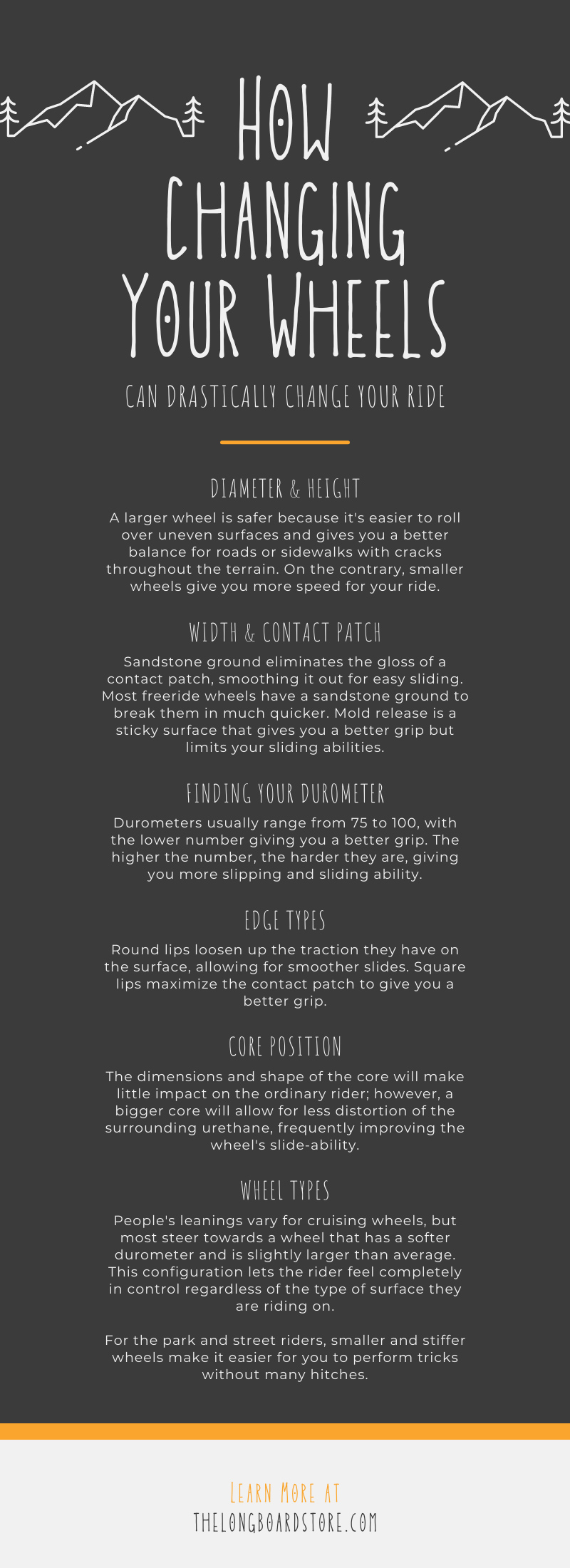It's challenging to decide which longboard you want to ride, so adding in the differences between wheels can lead to more confusion. Hopefully, this post will explain how changing your wheels can drastically change your ride to find the best pairing for your board.
Diameter & Height
The size of your wheels helps you board how you please. Like everything we discuss, there is no right or wrong way to ride, but you can better equip your longboard with the style that best fits you. The diameter and height of the wheels is the first thing you should consider for your board. Wheel dimensions are typically in millimeters (mm), and the height is frequently mentioned in the wheel title.
A larger wheel is safer because it's easier to roll over uneven surfaces and gives you a better balance for roads or sidewalks with cracks throughout the terrain. On the contrary, smaller wheels give you more speed for your ride. Gaining and maintaining top speeds is essential for downhill riders, which is why they often turn to smaller wheels. Everything in between is your personal preference and what works well for you. But remembering that larger wheels compromise speed for control and vice versa gives you an idea of what suits you.
Width & Contact Patch
The wheel's width is the distance between the inner and outer portions of the urethane wheel. While the width is an important consideration, the contact patch of your wheels is where the focus goes for most riders. The width and the contact patch may be identical for some wheels.
The contact patch is where the wheel directly interacts with the surface. With the shape of certain wheels, the edges may have curves or be rounded and not touch the ground. A wider contact patch gives your wheels more grip and gives you more control while riding.
The two contact patches are available to handle two surfaces: sandstone ground and mold release. Sandstone ground eliminates the gloss of a contact patch, smoothing it out for easy sliding. Most freeride wheels have a sandstone ground to break them in much quicker. Mold release is a sticky surface that gives you a better grip but limits your sliding abilities.
Finding Your Durometer
Another key factor in choosing your wheels is how hard they are. The durometer measures the firmness of the polyurethane. Wheels will have 70mm/75a measurements when you shop for them, and the durometer is that "a" figure. Durometers usually range from 75 to 100, with the lower number giving you a better grip. The higher the number, the harder they are, giving you more slipping and sliding ability.
Additionally, the durometer influences the wheel's speed. Lower durometer wheels provide a better grip on the road by slowing the wheel down. Harder and smoother wheels don't have those restrictions, allowing you to go faster.
Edge Types
We briefly discussed the types of edges your wheels have when discussing contact patches and width. The edge types or lips come in four distinct shapes: round, square, sharp, and beveled.
Round lips loosen up the traction they have on the surface, allowing for smoother slides. Square lips maximize the contact patch to give you a better grip. Some riders may opt for triangular beveled lips to get the best of both worlds. With these edges, you get a solid combination of grip and slide. Sharp edges give you the most grip among the four types, but they will slow you down significantly.
Your wheel edge selection should match the style you are riding. For example, you don't want to put sharp edges on when downhill riding because speed and sliding is your goal.
Core Position
The core is a spherical polymeric ring that supports the bearings and provides a location for the flexible polyurethane to connect. The dimensions and shape of the core will make little impact on the ordinary rider; however, a bigger core will allow for less distortion of the surrounding urethane, frequently improving the wheel's slide-ability.
What matters most about the core is its location inside the wheel and how it affects performance. The wheel's inner lip applies the most force when entering a slide. The amount of urethane accessible to enhance the wheel's grip depends on where the core is situated within the wheel.
Your wheels have three core placements: sideset, offset, and centerset. Sideset placement is fantastic for effortless slides because there is minimal urethane involvement. Offset wheels have a solid balance of grip and slide for any rider. Centerset wheels last longer because you can flip them when they start to wear down due to their symmetry. They provide the most grip among the three versions and have a high durometer to allow for better sliding.
Wheel Types
Now that you know the intricacies of choosing your wheels, let's break it down into the basic four riding methods to find the optimal wheels for your board.
People's leanings vary for cruising wheels, but most steer towards a wheel that has a softer durometer and is slightly larger than average. This configuration lets the rider feel completely in control regardless of the type of surface they are riding on.
For the park and street riders, smaller and stiffer wheels make it easier for you to perform tricks without many hitches. Harder wheels can cushion your drop without hampering your ability to coast on rails and ledges.
Downhill wheels depend on whether you want pure speed or have some semblance of control. If speed is your objective, large and hard wheels are your best bet. In contrast, smaller wheels offer you more control.
The form of most freeride wheels is like that of a typical shortboard wheel, but they are bigger and made of softer durometer urethane. Most will seem to be centerset, but they are slightly offset to provide a great mix of grip and glide. Because everyone slides differently depending on their size, weight, and riding style, freeride wheels offer the most range of variability in form, core location, and durometer.
Going above 75mm for a freeride wheel, on the other hand, increases the chance of bad sliding. This is due to the urethane used to provide the height deforming and gripping, making slides more difficult to commence and less predictable. Specifications for this wheel are in the rider's hands and what makes them comfortable.
After learning how changing your wheels can drastically change your ride, you can narrow down the type of wheels you need for drop through longboards for sale at The Longboard Store. We have various wheels in stock for all styles that work well on any longboard. If you don't know what style best fits you, take our quiz to help guide your way!


